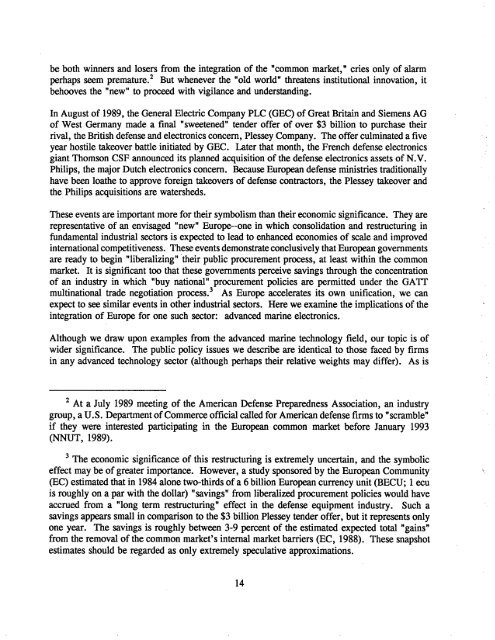WHOI-90-52
WHOI-90-52
WHOI-90-52
Create successful ePaper yourself
Turn your PDF publications into a flip-book with our unique Google optimized e-Paper software.
e both winners and losers from the integration of the "common market," cries only of alarm<br />
sem premature.2 But whenever the "old world" threatens institutional innovation, it<br />
perhaps<br />
behooves the "new" to proc with vigilance and understading.<br />
In August of 1989, the General Electrc Company PLC (GEC) of Great Britan and Siemens AG<br />
of West Germany made a final "sweetened" tender offer of over $3 bilion to purchase their<br />
rival, the British defense and electronics concern, Plessey Company. The offer culminated a five<br />
yea hostile taeover battle initiated by GEC. Later that month, the French defense electronics<br />
giant Thomson CSF announce its planned acquisition of the defense electronics assets of N. V.<br />
Philps, the major Dutch electronics concern. Beuse Europe defense ministries trditionally<br />
have been loathe to approve foreign taeovers of defense contrctors, the Plessey taeover and<br />
the Philps acquisitions are watersheds.<br />
These events are importt more for their symbolism than their economic significance. They are<br />
representative of an envisaged "new" Europe--one in which consolidation and restrcturing in<br />
fundamenta industral sectors is expeted to lead to enhance economies of scale and improved<br />
international competitiveness. These events demonstrate conclusively that Europe governments<br />
are ready to begin "liberalizing" .their public procurement procss, at least within the common<br />
market. It is significant too that these governments perceive savings through the concentration<br />
of an industr in which "buy national" procurement policies are permitted under the GATT<br />
3 As Europe acclerates its own unification, we can<br />
multinational trade negotiation process.<br />
expet to se similar events in other industral setors. Here we examine the implications of the<br />
integration of Europe for one such setor: advanced marne electronics.<br />
Although we draw upon examples from the advance marne technology field, our topic is of<br />
wider significace. The public policy issues we describe are identica to those faced by firms<br />
in any advance technology sector (although perhaps their relative weights may differ). As is<br />
2 At a July 1989 meeting of the America Defense Preparedness Association, an industry<br />
group, a U.S. Deparment of Commerce official caled for America defense firms to "scramble"<br />
if they were interested parcipating in the Europe common market before Januar 1993<br />
(NT, 1989).<br />
3 The economic significance of this restructuring is extremely uncertn, and the symbolic<br />
effect may be of greater importce. However, a study sponsored by the Europe Community<br />
(EC) estimated that in 1984 alone two-thirds of a 6 bilion Europe currency unit (BECU; 1 ecu<br />
is roughly on a par with the dollar) "savings" from liberalize procurement policies would have<br />
accrued from a "long term restrcturing" effect in the defense equipment industry. Such a<br />
savings appes small in comparson to the $3 billon Plessey tender offer, but it represents only<br />
one yea. The savings is roughly between 3-9 percent of the estimated expeted tota "gains"<br />
from the removal of the common market's internal market barers (EC, 1988). These snapshot<br />
estimates should be regarded as only extremely speulative approximations.<br />
14
















